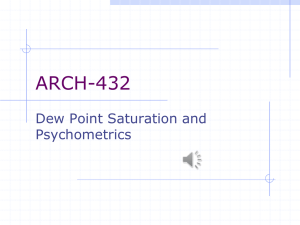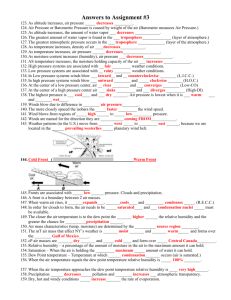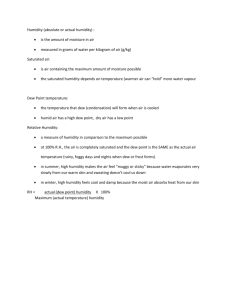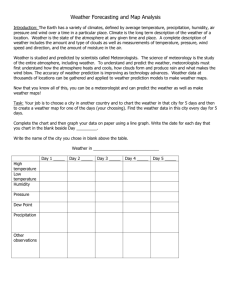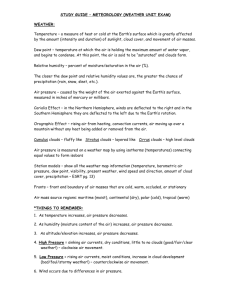It's the Dew Point Stupid!
advertisement
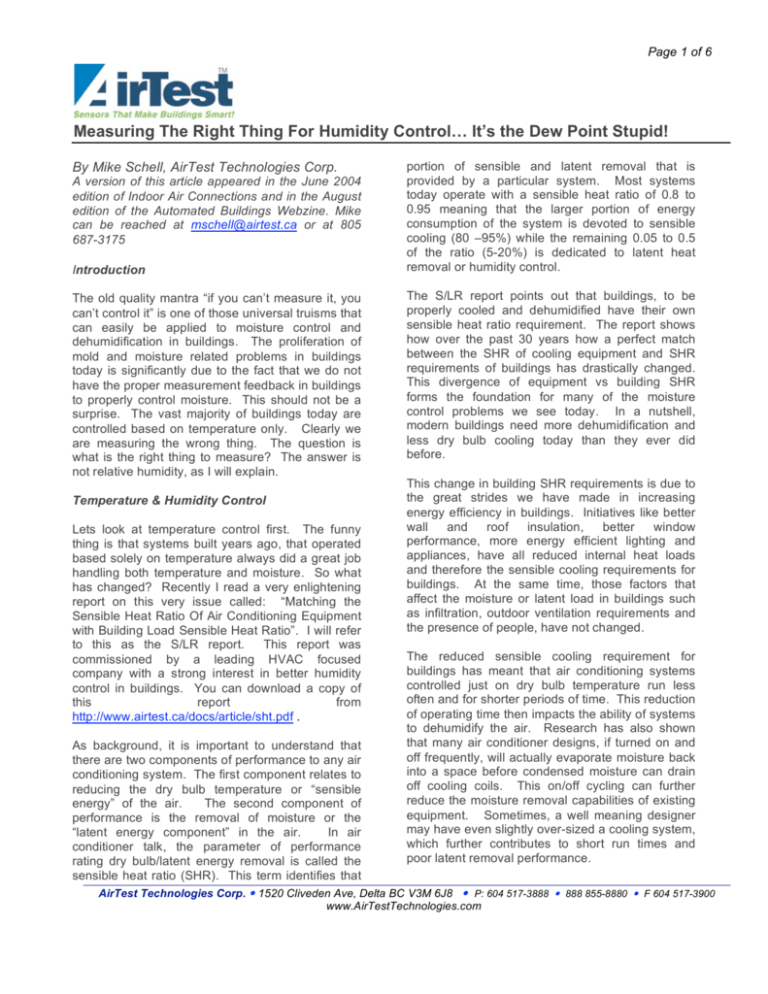
Page 1 of 6 Measuring The Right Thing For Humidity Control… It’s the Dew Point Stupid! By Mike Schell, AirTest Technologies Corp. A version of this article appeared in the June 2004 edition of Indoor Air Connections and in the August edition of the Automated Buildings Webzine. Mike can be reached at mschell@airtest.ca or at 805 687-3175 Introduction The old quality mantra “if you can’t measure it, you can’t control it” is one of those universal truisms that can easily be applied to moisture control and dehumidification in buildings. The proliferation of mold and moisture related problems in buildings today is significantly due to the fact that we do not have the proper measurement feedback in buildings to properly control moisture. This should not be a surprise. The vast majority of buildings today are controlled based on temperature only. Clearly we are measuring the wrong thing. The question is what is the right thing to measure? The answer is not relative humidity, as I will explain. Temperature & Humidity Control Lets look at temperature control first. The funny thing is that systems built years ago, that operated based solely on temperature always did a great job handling both temperature and moisture. So what has changed? Recently I read a very enlightening report on this very issue called: “Matching the Sensible Heat Ratio Of Air Conditioning Equipment with Building Load Sensible Heat Ratio”. I will refer to this as the S/LR report. This report was commissioned by a leading HVAC focused company with a strong interest in better humidity control in buildings. You can download a copy of this report from http://www.airtest.ca/docs/article/sht.pdf . As background, it is important to understand that there are two components of performance to any air conditioning system. The first component relates to reducing the dry bulb temperature or “sensible energy” of the air. The second component of performance is the removal of moisture or the “latent energy component” in the air. In air conditioner talk, the parameter of performance rating dry bulb/latent energy removal is called the sensible heat ratio (SHR). This term identifies that portion of sensible and latent removal that is provided by a particular system. Most systems today operate with a sensible heat ratio of 0.8 to 0.95 meaning that the larger portion of energy consumption of the system is devoted to sensible cooling (80 –95%) while the remaining 0.05 to 0.5 of the ratio (5-20%) is dedicated to latent heat removal or humidity control. The S/LR report points out that buildings, to be properly cooled and dehumidified have their own sensible heat ratio requirement. The report shows how over the past 30 years how a perfect match between the SHR of cooling equipment and SHR requirements of buildings has drastically changed. This divergence of equipment vs building SHR forms the foundation for many of the moisture control problems we see today. In a nutshell, modern buildings need more dehumidification and less dry bulb cooling today than they ever did before. This change in building SHR requirements is due to the great strides we have made in increasing energy efficiency in buildings. Initiatives like better wall and roof insulation, better window performance, more energy efficient lighting and appliances, have all reduced internal heat loads and therefore the sensible cooling requirements for buildings. At the same time, those factors that affect the moisture or latent load in buildings such as infiltration, outdoor ventilation requirements and the presence of people, have not changed. The reduced sensible cooling requirement for buildings has meant that air conditioning systems controlled just on dry bulb temperature run less often and for shorter periods of time. This reduction of operating time then impacts the ability of systems to dehumidify the air. Research has also shown that many air conditioner designs, if turned on and off frequently, will actually evaporate moisture back into a space before condensed moisture can drain off cooling coils. This on/off cycling can further reduce the moisture removal capabilities of existing equipment. Sometimes, a well meaning designer may have even slightly over-sized a cooling system, which further contributes to short run times and poor latent removal performance. AirTest Technologies Corp. 1520 Cliveden Ave, Delta BC V3M 6J8 P: 604 517-3888 888 855-8880 F 604 517-3900 www.AirTestTechnologies.com Page 2 of 6 The common practice of setback control, which often means turning cooling equipment off on nights and weekends to conserve energy, may be one of the most serious contributors to excessive moisture problems in buildings in humid climates. When the cooling system is off, infiltration will carry in substantial levels of outside moisture that get absorbed in building components. This combined with low sensible cooling loads means that the system never runs long enough to remove all the moisture in the air and building components. If the dry bulb temperature is low enough during operating hours, then high moisture levels and condensation may be widespread on critical surfaces. The homegrown science project begins! Control Of Humidity The implication of the information provided by the S/LR report is that we can no longer rely on temperature control in buildings to take care of moisture and humidity. The good thing to know is that there are plenty of approaches that can be used to better control the latent energy or moisture inside buildings. • Airflow Reduction: By reducing the flow of air through conventional cooling equipment, latent removal capability can be increased. However, too much flow reduction can cause freezing in the coil. • Overcooling with Reheat: Air traveling through the air conditioning equipment can be overcooled to remove additional moisture and then reheated. While some energy codes discourage this approach, there are now some innovative technologies using heat recovery methods to provide the reheat (e.g. heat pipes and rejected heat from cooling cycles). • Enthalpy Heat Recovery: Enthalpy recovery heat exchangers can be used to dry incoming outside air with dry air being exhausted from buildings. • Chiller Control: In large buildings that utilize chillers, cooling systems can operated to vary the SHR in real time depending on need. • Dedicated Outdoor Air Systems: In many cases buildings are now using dedicated systems that dehumidify and cool outside air separately from the space conditioning system. • Optimized Outdoor Air Control: Outdoor air can be one of the major sources of moisture in a building. CO2 based ventilation control can regulate the amount of air into a building to to provide real time control of outdoor air ventilation based on occupancy. This ensures that excessive levels of air and humidity are not introduced to the building to add to the moisture removal load. • Setback Control Based On Moisture Control: Cooling systems should not be turned off during unoccupied hours or days. A moderate setback should be used that will control humidity in the space or the space cooling during setback periods should be controlled based on latent energy concentrations in the space. • Economizer Control Based On Dew Point: Controlling fresh air economizers based on temperature or enthalpy can cause excessive levels of moisture to enter a building. As a result many buildings, including most government buildings are switching to dew point control. The US GSA has established that fresh air economizers should only operate until a 51ºF dew point is reached. Measurement Of Moisture For Control So we now know we can control moisture in buildings, but going back to the quality mantra you have to be able to measure something to control it. How do we best measure and control the amount of latent energy or moisture in a space? If you talk to a professional who deals with moisture control and dehumidification in extreme situations like water damage clean up, the answer will be to use a measure such as dew point or grains-per-pound of dry air which directly measures the latent energy. Relative humidity is of little or no use and in some cases can be downright counter productive as a moisture control parameter. • Variable SHR Equipment: Many manufacturers are now making unitary/ package cooling equipment for residential and commercial applications that can provide adjustable SHR output. AirTest Technologies Corp. 1520 Cliveden Ave, Delta BC V3M 6J8 P: 604 517-3888 888 855-8880 F 604 517-3900 www.AirTestTechnologies.com Page 3 of 6 walls and at a very different temperature than what we would typically measure in the space. The space temperature and associated RH measured will likely be very different than on the surfaces of concern. So while RH on the surface of a material is a good indicator of mold growth, RH in the space cannot be used to predict or control the moisture content on mold vulnerable surfaces. The Folly Of Relative Humidity Humidity measurement values like relative humidity and enthalpy are hybrid measurements that take into consideration both the sensible and latent component of air. For example relative humidity reflects the relative amount of water that air can hold at a given temperature. Change the temperature and the humidity will change even if net amount of moisture in the air remains the same. In fact a 1ºF change in room temperature can change the relative humidity by 2%. If outside air at 85ºF and 60% RH is cooled to 72 degrees without any moisture removal, the RH will increase to almost 90%. This temperature effect on relative humidity makes it useless as a moisture control parameter. Relative humidity has been closely linked to the growth of mold in a space but there is a fair amount of confusion on this point as well. Probably one of the best references to the measurement and control of moisture in buildings is the ASHRAE Humidity Control And Design Guide For Commercial And In Institutional Buildings (Available from ASHRAE) that clearly lays out the building science foundation and practices that can ensure moisture and mold control in buildings. This guide points out that the critical stimulus for the presence and growth of mold in the space is high levels of moisture on surfaces that serve as nutrients for mold. These could be surfaces such as wood, drywall and other organic materials. For most molds of concern growth will occur in when water content on these surfaces reach 70 to 100% RH. If liquid water can form through condensation or water leakage, a prolific growth environment is assured. Please note that the mold growth is tied to RH on the surface of the host material. This material may be in the ductwork, in carpet, or on the inside of The key to controlling moisture in buildings is to directly measure the latent content (moisture) of air separate from its sensible (dry bulb) component. This is where measurements such as dew point and grains/lb of dry air come into play. Temperature will not affect either of these measurements. Figure 1: Comparing RH, Dew Point and Grain Measurements. Dew Point Dew point is really a predictive measure that indicates the temperature at which moisture in the air will reach 100% and condense onto a surface. It can be a useful measure for controlling moisture AirTest Technologies Corp. 1520 Cliveden Ave, Delta BC V3M 6J8 P: 604 517-3888 888 855-8880 F 604 517-3900 www.AirTestTechnologies.com Page 4 of 6 levels to avoid mold growth because it is usually very easy to determine the temperature of the coldest surfaces within a building. To ensure high moisture levels or condensation does not occur on those surfaces, dew point levels in the air should be controlled in the building to below temperature of the coldest surfaces in a space (e.g slab on grade floor or un-insulated duct sections). This will ensure that moisture conditions never approach the point that would sustain mold growth on cooler surfaces. . Humidity Ratio (Grains) The measure of Grains/lb of dry air, called the humidity ratio and is an indication of the mass of water vapor in air. This measure is most useful to designers and operators of dehumidification equipment because it can be used to predict the specific amount of energy necessary to remove a given amount of moisture from air. This measure is ideal for building control, where your control strategies are based on maintaining a given target level of moisture control. This is typically the measure preferred by companies offering dehumidification systems for water damage and industrial applications. and for many are considered more esoteric. Today, low cost methods of measuring the latent component are now available: Dew point and grains values can be calculated from s RH and temperature measurement using either a fairly complicated formula or look up charts and tables. However, with the availability of low cost microprocessors, many hand held and building control systems are now capable of easily calculating this value. The important thing to remember is that both the humidity and temperature sensor should see exactly the same conditions for the calculation to be accurate. The sensors being used to measure temperature and humidity should also be accurate. The accuracy of the calculation method should also be considered. Figure 2 shows a hand held device that can display RH Temp, and calculates dew point and humidity ratio. Figure 3: EE10-Td Wall Mount From AirTest, Measures Temp & RH or Temp & Dew Point Figure 2: Hand Held With Dew Point & Humidity Ratio Figure 1 shows the relationship between dew point, grains and relative humidity. This chart shows how RH can change with temperature but the latent content of air is unaffected by temperature. For a designer a chart like this could be used to select the ideal conditions desired in the space for comfort in terms of temperature and relative humidity. The control strategy for the space would then be to maintain the latent conditions in the space that are equivalent to that design target. Cost Effective Measurement Technology Relative humidity has been one of the most inexpensive means of humidity measurement and is today widely used and understood. Dew point and grains measurements have involved much more elaborate and traditionally expensive equipment Because of the evolution more powerful microprocessor technology, it is now possible to accurately calculate dew point on board a wall or duct mount sensor with accuracies that are better than many chilled-mirror approaches. This capability is available for just a small additional cost over a standard temperature and humidity sensor. This type of sensor is ideal for providing feedback for better moisture control inside buildings. Also with the increased used of chilled ceilings, floors and beams for radiant cooling, a accurate wall mount sensor like the EE10-Td can help prevent conditions that might result in formation of condensation on surfaces. This condensation can cause staining, possible safety issues and may result in moisture related damage. This type of AirTest Technologies Corp. 1520 Cliveden Ave, Delta BC V3M 6J8 P: 604 517-3888 888 855-8880 F 604 517-3900 www.AirTestTechnologies.com Page 5 of 6 technology is also being used in supermarkets to better control humidity to prevent frosting on frozen food display cases. Outdoor Air Sensing Measurement of outdoor dew point can be a very important parameter in better controlling moisture in buildings. This is because outdoor air introduced through ventilation is the major source of moisture inside buildings. Buy EE23 Sensor For Outside understanding Air Dew Point & outside moisture and Temperature how it is changing, better decisions on pre-cooling spaces, overriding temperature set back or using a dew point setback can be used to ensure indoor spaces can be controlled under heavy outdoor moisture conditions. Economizer Control Under the right conditions, outdoor air can also be used for free cooling through the use of an economizer cycle. A typical building can save thousands of dollars with the right economizer control. Unfortunately most economizer strategies utilize sensors that are undependable and inaccurate. The most commonly used enthalpy sensors used in the industry do not even state accuracy on their data sheets. Check for yourself. Why use something that has no stated accuracy? The problem with economizer control becomes further compounded with a dual enthalpy approach, when two sensors of unstated and unknown accuracy are used to try and sense the difference between outside air and return air. Even if you were able to find an accurate enthalpy sensor, enthalpy is the wrong thing to measure. Enthalpy is a measure of the total heat in air both sensible and latent. However in using enthalpy there may be times when total enthalpy appear acceptable, but outdoor moisture levels will be well above design conditions. In many cases, building operators have recognized the poor quality of enthalpy sensors and have decided to use temperature as the control for economizers. Again this strategy will add moisture to the space that will ultimately have to be air conditioned out later. In fact in many climates the extra loading of moisture brought in by temperature control will almost negate the benefit of sensible cooling provided by outside air. As we learned earlier in this article, we are already operating our buildings in a way that can aggravate moisture problems that can lead to discomfort, health problems or complete structural failure. A enthalpy or temperature based economizer strategy provides just one more source of moisture that a building really does not need. Increasingly economizer control based on dew point and temperature is becoming the trend. With this approach, the economizer will only be activated when there is a call for cooling and outside levels of dew point and temperature are at a point where they truly can provide “free” cooling. From a moisture perspective, this means that outside dew point should be below indoor design conditions. The table below shows a variety of dew point conditions and the corresponding dew point limit. Indoor Design Conditions & Dewpoint Temperature (ºF) 75 74 73 72 71 70 %RH Target Dew Point (ºF) 60% 50% 60% 50% 60% 50% 60% 50% 60% 50% 60% 50% 60.2 55.1 59.3 54.2 58.3 53.3 57.4 52.4 56.4 51.5 55.5 50.5 Rather than establishing an economizer dew point limit based on indoor design conditions, many building operators and building designer prefer to select a dew point equivalent to what their cooling system would normally deliver. If “free” cooling is the objective, shouldn’t outside moisture conditions be somewhat equivalent to that delivered by the air conditioning system? Otherwise any load introduced to the building will ultimately have to be removed in a later pass through the system. This adds load to the cooling system and imposes unnecessary energy penalty. AirTest Technologies Corp. 1520 Cliveden Ave, Delta BC V3M 6J8 P: 604 517-3888 888 855-8880 F 604 517-3900 www.AirTestTechnologies.com Page 6 of 6 An important consideration when measuring outside conditions for humidity, temperature or dew point is that the most accurate sensor will give horrible results if mounted incorrectly. Radiation shields are used widely in weather station measurements because they can effectively negate measurement interferences from solar radiation, rain, snow and wind effects. AirTest offers two types of weather-station-quality sensors with radiation EE21 RH & Temp shields for outdoor air Sensor with Radiation measurements. Shield 1) The EE23 offers a temperature and a accurately calculated dew point output (± 0.8ºF Td) 2) The EE21 and EE08 offer a accurate outside temperature and humidity measurement that can be converted to a dew point value by a building control system. These outside air sensors are specifically designed to work in outdoor environments for years on end and can be expected to operate for ten years or more with minimal drift. AirTest also offers a special environmental coating that can stand up against salt air usually found in costal areas. Asides from accuracy of measurement, there are some clear advantages to using a central dew point and temperature sensor to activate an outside air economizer strategy. • While a weather EE08 RH and Temp station quality Sensor For Outside Air sensor cost more, With Screw-In Probe one sensor can be used for all air intakes or unitary equipment on a building. • Some contractors have found that the total first cost is much less for a central outside sensor vs redundantly wiring each air handler • • • with a separate temperature or enthalpy sensor. Outside air sensors are made to be durable and should last for years without need for calibration or maintenance. If service is required sensors are easily accessible. Rather than relying on relay-level control logic inside an air handler to activate the economizer, decision-making can be centrally controlled and monitored. By understanding outside air conditions, a building operator may be able to better configure a building and control system to save energy and protect against moisture related problems. For further information on dew point economizer control contact AirTest for their Guide to Economizer Control. Conclusion Just a few years ago, dew point was a very difficult parameter to measure. It often required very expensive, sensitive instrumentation that often required significant computing power. Historically, dew point measurements have not been sued because it was not technically or economically feasible for the buildings market. Today, things have changed. The advancement of microprocessor technology has now made it possible to easily perform the complex calculation of dew point using accurate temperature and humidity readings. As discussed in the beginning of this paper, since the SHR of existing temperature controlled cooling equipment no longer matches the SHR requirements of buildings a separate measure of the latent component of air in the building is necessary to provide control for moisture. Equipment capable of controlling moisture is readily available; the problem has been the lack of an affordable and dependable sensor feedback control for measuring latent content of air. The right thing to measure in buildings is dew point. The recent breakthroughs in affordable dew point measurement mean we have a better tool for controlling all aspects of building operation from cooling, to economizer control to dehumidification control. Revised 8/15/08 AirTest Technologies Corp. 1520 Cliveden Ave, Delta BC V3M 6J8 P: 604 517-3888 888 855-8880 F 604 517-3900 www.AirTestTechnologies.com
